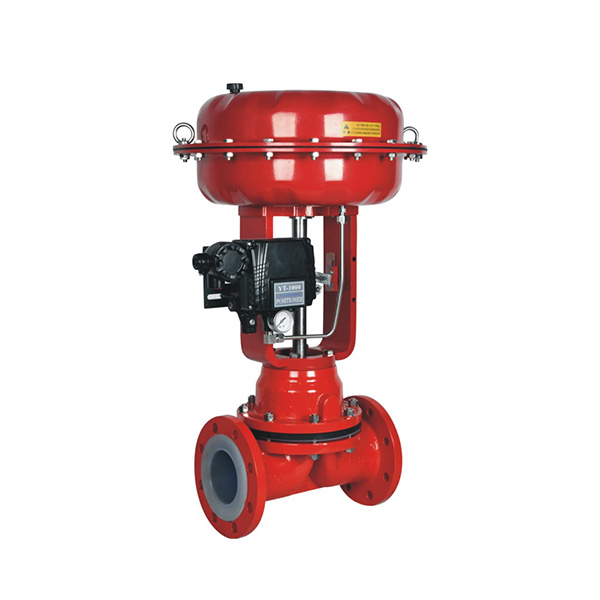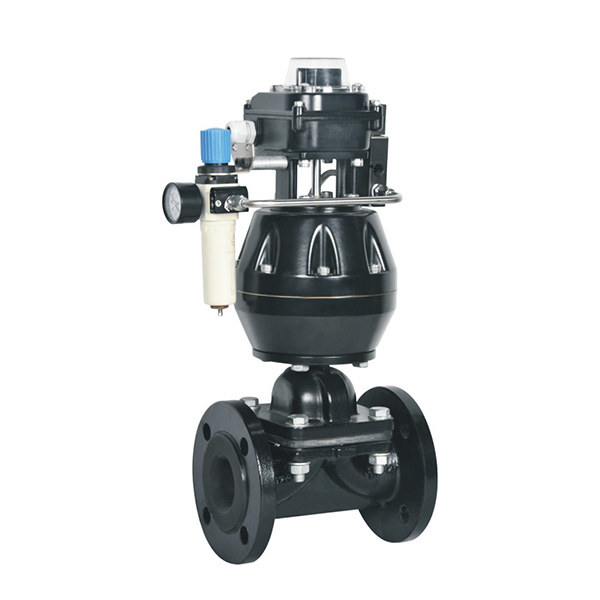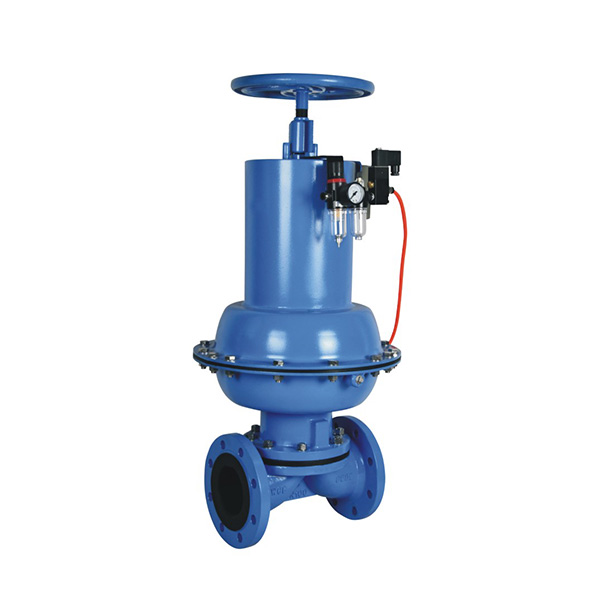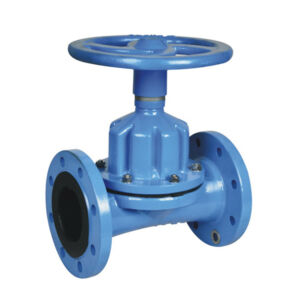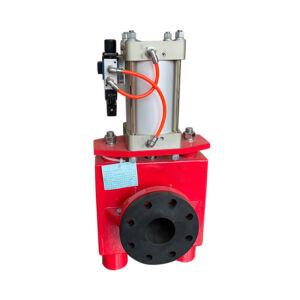Features:
Leflow’s Diaphragm valve is designed to handle media that are aggressive or contain suspended particles,It has following options:
1.Body: Weir type(A type) and Straight through type(KB type);
2.Body coating: Unlined, Many kinds of Rubber(Natural Rubber,EPDM and Butyl),
Many kinds of Fluorine plastic(PFA,PVDF,TFE and so on);
3.Diaphragm:Many kinds of Rubber(Natural Rubber,EPDM and Butyl),
Many kinds of Fluorine plastic(PFA,PTFE AND FEP);
4.Ends:Flanged or Screwed;
5.Operation: Manual,Pneumatic and Electric;
6.Testing: Lining layer check: BS6755 Electric spark detecting;
Body strength test:1.5 times rated working pressure;
Seat test:1.1 times rated working pressure.
7.Surface coating: All kinds of paint or Fusion Bonded Epoxy.
Diaphragm valve is a special valve and its main function is to control the flow of fluid and adjust the flow of fluid. Its core components include a diaphragm and a valve stem. The diaphragm is usually made of elastic and corrosion-resistant non-metallic materials such as rubber or plastic, and the valve stem is connected to the diaphragm. When the stem is raised and lowered, the diaphragm moves accordingly, changing the clearance between the diaphragm and the seat, thereby controlling the flow and regulation.
Here is how the diaphragm valve works:
When the diaphragm valve is closed, fluid enters the valve body through the inlet channel. At this point, the pressure on the valve cover causes the lower part of the diaphragm to fit tightly with the seat, creating a seal.When the stem rises, the diaphragm also rises, opening the valve; Instead, when the stem drops, the diaphragm drops, closing the valve.
By controlling the up and down movement of the valve stem, the opening of the valve can be adjusted to realize the flow control of the fluid.
The diaphragm valve is a special on/off valve and has following benefit:
1.The elastic cone components can avoid the inner leak;
2.The clipper-built interior channel can reduce the head loss;
3.It has no stuffing box,so it doesn’t leak from stem;
4.The stem and bonnet are separated by the middle diaphragm in order that both of them aren’t corroded by the medium;
5.The diaphragm is changeable and the maintenance cost is low;
6.The various lining materials are available as below chart.
Rubber Series: Materials and scope of application of body lining
| Material | Code | Suitable temperature | Applicable medium |
| Hard rubber, Ebonite | NR | -10℃~85℃ | Hydrocyanic acid,50% fluorosilisic acid, hydrochloric acid,30% sulfuric acid, 50% hydrofluoric acid,85%phosphoric acid,alkali, salt,metal-plated solution,sodium hydroxide, potassium hydroxide, neutral salt solution, 10% sodium hypochlorite,humid chlorine ammonia,alcohol,organic acid and aldehyde except for the strong oxident (such as nitric acid,chormic acid,strong sulfuric acid and perhydrol and organic solvent). |
| Soft rubber | BR | -10℃~85℃ | Have good abrasion resistance.Be mainly suitable for less than 50% sulfuric acid,sodium hydroxide, potassium hydroxide,neutral salt solution,ammonia,cement,clay,cinder,chemical fertilizer grain, strong abrasive solid-state liquid and slime in all kinds of densities. |
| Isobutylene-isoprene rubber, butyl rubber | IIR | -10℃~120℃ | Be corrosion resistant and abrasion resistant.Be suitable for some organic acid, alkali, hydrate, mineral salt,elementary gas,alcohol, aldehyde, aether, ketone,ester, ≤30% sulfuric acid, phosphoric acid, hydrofluoric acid,animal oil, plant oil,corrosive alkali and ester. |
| Neoprene rubber | CR | -10℃~105℃ | Animal oil,plant oil,inorganic lube,corrosive slurry with large change scope of PH value. Good abrasion resistance. |
| Cast iron unlined | ≤100℃ | Noncorrosive medium | |
| Stainless steel, unlined | ≤150℃ | Usual corrosive medium | |
| Note: The temperature of application are shown as reference only, It may change as Pressure, Temperature and other related condition. | |||
Rubber Series: Materials and scope of application of diaphragm
| Material | Code | Suitable temperature | Applicable medium |
| Isobutylene-isoprene rubber | IIR | ≤120℃ | Except for >75% sulfuric acid, >20% hydrochloric acid, <60% hydrofluoric acid, >85phosphoric acid,corrosive alkali and ester |
| Natural rubber | NR | ≤85℃ | Purified water,mineral salt and diluent mineral acid etc |
| Ethylene-propylene -diene meyhylene Vistalon |
EPDM | ≤120℃ | Have the acid resistance and alkali resistance like the natural rubber and be suitable for application in the low- pressure steam,hot water and cold water |
| Chloroprene rubber | CR | ≤85℃ | Acid-resistant and alkali-resistant and the non-polar solvent and the abrasion resistance are better than the natural rubber |
| Nitrile,Buna-N | NBR | ≤85℃ | Oil-resistant and abrasion resistant and the acid resistance is the same as the natural rubber |
| Hypalor | CSPE | ≤120℃ | The product has the features of ozone resistance, atmospheric aging resistance,acid and alkali resistance,oxidant and many kinds of chemical medicine resistance,and burning resistance heat resistance but no resistance to petroleum and arene |
| Fluoroelastomer,Vito | FKM | ≤150℃ | Have the corrosive resistance like the flouro plastic. Be very stable in the strong acid and strong oxidant and be stable in the organic solvent and alkali solvent. |
| Silicone rubber | SI | ≤200℃ | Be heatproof,excellent electricity insulation capability and wearable;may resist corrosion of dilute acid,dilute alkali,salt and water,can’t resist corrosion of petrolic products such as gasoline coal oil etc |
| Note: The temperature of application are shown as reference only, It may change as Pressure, Temperature and other related condition. | |||
Fluorine Series: Materials and scope of application of body linings
| Material | Code | Suitable temperature | Applicable medium |
| Fluorinated ethylene propylene |
FEP、F46 | ≤150℃ | Different density hydrochloric acid,sulfuric acid,hydrofluoric acid,aqua regia,nitric acid,all kinds of organic acid,alkali, alternation of strong acid and weak acid,alternation of acid and alkali,many kinds of organic solvent and other strong corrosive media except for melt alkali metals,element fluorin and aromatic hydrocarbon.
|
| Polychlorotri fluoroethylene | PCTFE、F3 | ≤120℃ | |
| Polyvinylidene fluoride | PVDF、F2 | ≤120℃ | |
| Ethylene tetrafluoroe-thylene,Tefzel | TFE/E、F40 | ≤120℃ | |
| Perfluoroalkoxy | PFA | ≤180℃ | |
| Acid-resistant enamel | ≤100℃ | General corrosive media except for hydrofluoric acid,strong phosphoric acid and strong alkali. | |
| Reinforced polypropylene | RPP | ≤100℃ | Most of organic acids,mineral acids and inorganic solvents except for strong nitric acid,oleum,chloride sulfonic acid and strong oxidant. |
| Polyolefin | PO | ≤100℃ | The product adapts to transport current medium,for example corrosive gas,liquid as well as solid and liquid slurry.It has good corrosion resistance to hydrochloric acid, dilute sulfuric acid,hydrofluoric acid,alkali and salt solution.It has the features of static resistance,innocuity. |
| Castiron unlined | ≤100℃ | Noncorrosive medium | |
| Stainless steel,unlined | ≤150℃ | Usual corrosive medium |
Fluorine Series: Materials and scope of application of diaphragm
| Material | Code | Suitable temperature | Applicable medium |
| Fluorinated ethylene propylene | FEP | ≤120℃ | Different density sulfuric acid, hydrofluoric acid,aqua regia, high-temperature strong nitric acid,all kinds of organic acid, strong oxidant, alternation of strong acid and weak acid, alternation of acid and alkali,many kinds of organic solvent etc. |
| Perfluoroalkoxy | PFA | ≤150℃ | |
| Teflon | PTFE | ≤180℃ | Also have the good features of corrosion resistance,heat and electric resistance,viscosity resistance and low frictional coefficient. |
Equipped accessories:
The pneumatic diaphragm valve can be equipped with the following accessories according to the needs:
1.Signal feedback device:feed back the open or closed state to the control room by the open or closed degree signal.
2.Limit switch:Limit the maximal aperture of valve in order to realize the flow control.
3.Positioner:
Positioner of electric-pneumatic valve:input the signal of 4~20mA current to control the open and closed degree in order to realize the flow control.
Positioner of pneumatic-pneumatic valve:input the signal of 0.02~0.10MPa air pressure to adjust the flow capacity.
4.Sensor of the position of valve:Operate valve in any position by the signal of 4~20mA current.
5.Pressure reducing valve:Regulate the air pressure according to the needs.
6.Solenoid valve:Control the change of airflow of pneumatic valve by the signal of current in order to open and close the valve.
7.The other accessories can be equipped according to the needs.



